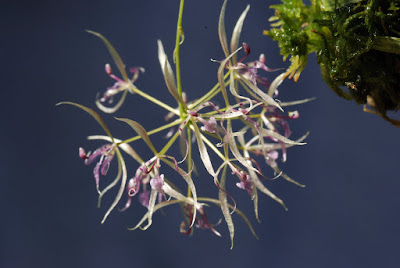Macroclinium orchid is native to the tropical Western Hemisphere and is related to the genus Notylia. All species grow epiphytic 400-1900m...
Macroclinium orchid also called as Sarmenticola, is a genus from the orchid family. This genus was described by Joao Barbosa Rodigues in 1882. There are to date 42 species in this genus.
IDENTIFY MACROCLINIUM ORCHID
Macroclinium orchid is native to the tropical Western Hemisphere and is
related to the genus Notylia. All species grow epiphytic at altitudes ranging
from 400 to 1900 meters above sea level. They grow under warm to cool climates
with even moisture and rain the whole year.
The species of this genus are herbs perennial, epiphytic, caespitose, pseudobulbous to submonopodial. They are characterized by the fan shaped growth of the plants composed of compressed leaves and sheaths from which the inflorescence arises, giving rise to flowers with the sepals and petals alike and usually sagging, a lip that is long stalked, usually with a elliptic blade. The shape of the lip and the way it is placed to the column are the distinguishing feature between the species within this genus.
These plants are generally twig-epiphytes that aren’t long lived in culture although they are not too difficult to care.
MACROCLINIUM ORCHID CARE AND CULTURE
Cultural information should only be used as a guide, and should be to be adapted to suit you. Your physical location; where you grow your plants, how much time you have to devote to their care, and many other factors, will need to be taken into account. Only then can you decide on the cultural methods that best suit you and your plants.
Light:
Macroclinium orchid needs a light level of 12000-20000 lux. These plants need filtered or scattered light and protection from direct sunlight. Strong air movement should be ensured all the time.
Temperature:
The average summer temperature in the summer is 25 ° C, the average night is 15 ° C, which gives a daily amplitude of 10 ° C. The average winter temperature is 22-23 ° C during the day and 11-12 ° C at night, giving a diurnal difference of 9-12 ° C.
Humidity:
The plants from this species needs the humidity of 75-80% for most of the year, in winter for a month or more it drops to around 70%.
Substrate, growing media and repotting:
Macroclinium orchid grows best firmly attached to washers from pieces of tree fern. However, such plants require high humidity, and during hot and dry weather, they should be watered several times a day.
They can also be grown in small pots or baskets using a very airy, fast-drying substrate, which decomposes slowly. These plants are very sensitive to any manipulations, so you should overdo them as little as possible. A good substrate for these plants is cut wood fiber ferns with the addition of chopped sphagnum moss and pieces of pearlite, which provide the substrate with a loose structure, breathability and retain some moisture. The addition of charcoal also helps to keep the substrate cool and prevents it from getting sour.
The plants should be repotted immediately after noticing signs of substrate decomposition, or every few years when the plant grows out of the pot. If repotting is done at the time when new roots begin to appear, the plant will be accepted and rooted in the shortest possible time.
Watering:
The plants should be watered abundantly during periods of intensive growth, but excellent drainage should be ensured so that the ground around the roots is never spread or soggy. When new growths reach maturity in the autumn, the amount of water should be reduced.
Fertilizer:
During the active growth, the plants should be fertilized every week 1/4-1/2 of the recommended dose of fertilizer for orchids. You can use sustainable fertilizer throughout the year. You can also use high-nitrogen fertilizer from spring to mid-summer, passing in late summer and autumn to high phosphorus fertilizer.
Rest period:
Macroclinium orchid does not need rest period in winter to stimulate flowering. But it require less water in winter, and should not be dry for a longer period. Quite frequent morning fogging between rare, light watering should provide enough moisture, while allowing the necessary dry rest. Fertilization should be reduced or eliminated until new growths appear and a more abundant spring watering begins.
BUY MACROCLINIUM ORCHID AND RELATED PRODUCTS:
BUY ANOTHERS SPECIES AND VARIETIES OF OTHERS GENUS HERE!















COMMENTS